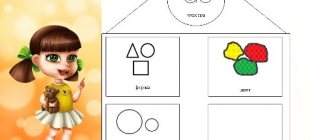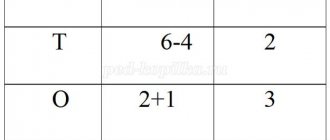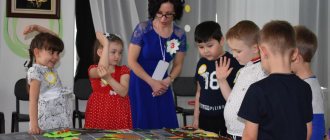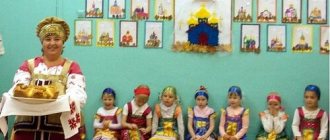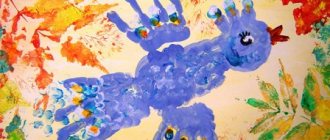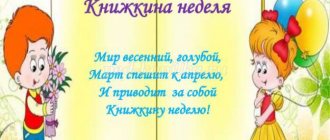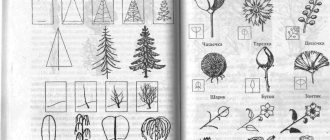Senior group. Senior preschool age. Children 5-6 years old
Master class for parents “Development of fine motor skills of the hands in children 4–5 years old with disabilities” Purpose: to acquaint parents of children of middle preschool age with the influence of fine motor skills of the fingers on the development of children’s speech. Objectives: to give basic ideas to parents about fine motor skills of the hands; replenish parents’ about the development of fine motor skills of children’s hands at home...
Parent meeting "Development of sound culture of speech in children of senior preschool age" Parent meeting "Development of sound culture of speech in children of senior preschool age"
Progress: Good afternoon, dear
parents! We are very glad to see you at our meeting dedicated to the problem of speech development in preschoolers. Speech development is the most important acquisition of a child...
Parent meetings in the middle group
Parent meetings in the middle group
I
Meeting.
Topic:
“Towards new knowledge in the new academic year!”
Tasks:
consider the age and individual characteristics of children 4-5 years old; introduce parents to the tasks and features of educational work, the tasks of the preschool institution for the new school year; teach parents to observe the child, study him, see successes and failures, try to help him develop at his own pace; to intensify work on the development of children's speech through role-playing games.
Agenda.
- Introductory part.
- Congratulations to parents on the beginning of the school year.
- Pedagogical comprehensive education “Child 4-5 years old”.
- Features of the educational process in the middle group.
- Familiarizing parents with the goals and objectives of the preschool educational institution for the new school year.
- Briefly about different things.
II
Meeting.
Topic: "The Age of Why".
Tasks:
Form trusting and friendly relationships between parents and children, teachers and students, teachers and parents. Develop self-awareness of parents and teachers; constructive ideas about children (parents) and students (teachers). Summarize parents' ideas about the individual characteristics of children of middle preschool age, use them in the process of family education; contribute to the formation of the correct attitude of parents towards the individual characteristics of their child.
Agenda.
1. Discussion “Do you know your child?”
2. Message on the topic: “The Age of Why”
3. Approval of the composition of the parent committee - initiative group
4. Comic test
5. Miscellaneous
III
Meeting.
Topic:
“Children play - let’s play together.
The role of play in the development of preschool children." Target:
to form the concept of parents about the possibility of play as a means for the development of intellectual and cognitive activity. Stimulate parents' interest in joint play activities with their own child. Introduce parents to educational games that they can play with their children at home. Discuss the issue of organizing a play environment in kindergarten and family settings; about the advantages and disadvantages of toys.
Agenda. 1. Introduction. Exercise “Associations” 2. Teacher’s story “Game” 3. Analysis of the survey 4. Viewing the presentation “Children play - let’s play together”
- Practical part “Let's play”
- Miscellaneous
IV
Meeting.
Topic: “ How our children have matured and what they have learned this year .
Target:
summing up the results of the joint educational process. To familiarize parents with the diverse interests and hobbies of the group's pupils, to interest parents in the development of the mental and creative abilities of their children.
Summary of the parent meeting Topic: “Senior preschool age, what is it like?”
MUNICIPAL BUDGETARY PRESCHOOL EDUCATIONAL INSTITUTION
"KINDERGARTEN No. 37 "ROSINKA" VORKUTA
Parent meeting in the senior group "Rosinka"
Topic: “Senior preschool age, what is it like?”
Participants: Teachers, parents.
Yashchenko Elena Mikhailovna
Educator
October 2021
Parent meeting in the senior group "Rosinka"
Topic: “Senior preschool age, what is it like?”
Purpose: To familiarize parents of pupils with the age characteristics of children in the senior group.
Objectives: Consider the age characteristics of children 5–6 years old, introduce parents to the educational process in the older group. Promote the emotional rapprochement of all participants in the educational process and organize their communication.
Meeting plan:
1. Introductory part.
2. Speech by the head “Comprehensive safety of preschool educational institutions. Registration of compensation for part of the parental payment for childcare and supervision.”
3. Age characteristics of children 5-6 years old.
4. Familiarization of parents with the educational process in the senior group.
5. Game “Color the flower”
6. Briefly about miscellaneous things.
7. Selection of the parent committee.
8. Final part.
Progress:
Introductory part.
Educator: Good evening, dear parents! We are very pleased to see you at the meeting today. We will begin our meeting with the selection of a secretary.
New children have joined our group - let's get to know each other. (Welcome and introduction to parents of new children). This is how we met.
The manager came to meet us. We give her the floor.
Speech by the head on the topic: “Comprehensive safety of preschool educational institutions. Registration of compensation for part of the parental payment for childcare and supervision.”
Speech on the topic: “Age characteristics of children 5-6 years old.”
Each child develops in his own way, each has his own path and pace of development.
We present to your attention a general age portrait of a 5-6 year old child, with indicators of different aspects of his development.
Age 5 - 6 years is the senior preschool age. It is a very important age in the development of the child’s cognitive sphere, intellectual and personal.
At 5-6 years old, a child absorbs all cognitive information like a sponge. It has been scientifically proven that a child at this age remembers as much material as he will never remember later in his life. At this age, the child is interested in everything related to the world around him and expanding his horizons. The best way to get scientific information is to read a children's encyclopedia, which clearly, scientifically, in accessible language describes to the child any information about the world around him. The child will gain an understanding of space, the ancient world, the human body, animals and plants, countries, inventions and much more.
This period is called sensitive, i.e. most favorable for the development of all cognitive processes: attention, perception, thinking, memory, imagination. To develop all these aspects, the game material becomes more complex, it becomes logical, intellectual, when the child has to think and reason.
It is good at this age to play word games with the child, since the child already uses synonyms and antonyms in his speech, distinguishes between vowels and consonants, and can determine the number of syllables in words, the place of the sound in the word (beginning, middle, end of the word).
The designer develops logical thinking well. The important point here is folding according to a pattern - a pattern, starting with simple patterns. Cubes, various puzzles, mosaics must be laid out according to the picture, focusing on color, shape, size.
Various logical tables develop all analyzers - visual, logical, verbal. For example, the game “Odd Four” - the pictures show various objects. Of the four items, one is extra. The child must think and choose this extra item and say why it is extra. Game "Place in order." A series of illustrations are offered, related to the same theme, but laid out incorrectly. The child must determine which of the illustrations depicts what happened earlier or later - that is, put it in order. Here the child must see the sequence, trace the logical pattern and justify it.
At the age of five, cognitive and intellectual spheres actively develop. And the better developed attention, perception, thinking, memory, imagination, the better and faster the child develops, the better prepared he is for school.
Speech on the topic: Introducing parents to the educational process in the senior group.
We would like to remind you that we are now the senior group. Our daily routine, hours and number of classes per day have changed. Now each lesson lasts 25 minutes and there are 12 lessons per week.
Your children have gotten older, and as a result, their responsibilities have increased. Both the program and teaching methods acquire the character of educational activity.
In order for the educational process to be properly organized, in our work we rely on the main regulatory documents regulating the activities of preschool educational institutions:
- The federal law ;
- Federal State Educational Standard for Preschool Education;
- SanPin 2.4. 1. 2660-10.
- International Convention on the Rights of the Child.
We work according to the preschool education program “From birth to school” edited by Veraksa N.E., Vasilyeva T.S., Komarova M.A.
We prepare children for school, develop perseverance, curiosity, attention, and memory. And it is the joint work of us teachers and you, parents, that can give a positive result.
We would like to introduce you to what children should know by the end of the school year.
Cognitive development:
Formation of elementary mathematical concepts.
By the end of the school year, children should be able to count objects within 10. Be able to indicate the number of objects with the corresponding number.
Be able to divide a square into 4 equal parts and name the parts.
Be able to navigate on a sheet of paper, determine the sides, corners and middle of the sheet.
Be able to distinguish and name flat and three-dimensional geometric shapes (circle, square, triangle, rectangle, ball, cube, cylinder).
Be able to consistently name the days of the week, determine what day of the week is today, what it was yesterday, what it will be tomorrow.
Familiarization with the social and objective world:
Have some ideas about educational institutions (school, kindergarten, college, university, etc.).
Have ideas about professions.
Have an idea of how seasonal changes affect people's lives and work.
Have primary ideas about the diversity of peoples of the world, races, nationalities.
Classify and compare objects by purpose, color, material, shape.
Distinguish and name types of transport.
Getting to know the natural world around you:
Have an understanding of living and inanimate nature, seasonal changes in it and human activities. About plants, mushrooms, animals, as representatives of living things in the natural world, their basic life functions and needs, and habitat. About natural communities of animals and plants, their relationships and features of adaptation to the environment and seasonal changes in it.
Speech development:
Use all parts of speech, actively engage in word creation, use synonyms and antonyms.
Choose several adjectives for the noun; replace a word with another word with a similar meaning.
Determine the place of a sound in a word, divide the word into syllables, count the letters in a word, come up with a word starting with a given letter.
Share various impressions with the teacher and other children, refer to the source of the information received (TV show, story of a loved one, visiting an exhibition, children's play, etc.).
Make up your own short story on a given topic.
Have a fairly large vocabulary.
Participate in the conversation and express your opinion.
Compose stories based on a plot picture, based on a set of pictures; consistently, without significant omissions, retell short literary works.
Retell short tales and stories coherently, consistently and expressively.
Artistic and aesthetic development:
In drawing:
Create images of objects (from life, from an idea), plot images.
Use a variety of compositional solutions and visual materials. Know the features of visual materials.
Use different colors and shades to create expressive images.
Make patterns based on folk arts and crafts.
In sculpting:
Sculpt objects of different shapes using learned techniques and methods of sculpting.
Create small plot compositions, conveying proportions, poses and movements of figures.
Create images based on folk toys.
In the application:
Depict objects and create simple plot compositions using a variety of cutting techniques and tearing paper.
In design:
Design according to your own ideas.
Analyze a sample building.
Plan the stages of creating your own building, find constructive solutions.
Create buildings according to a drawing or diagram.
In music:
Distinguish between genres of musical works (march, dance, song); sound of musical instruments (piano, violin).
Distinguish between high and low sounds.
Sing without tension, smoothly, with a light sound; pronounce words clearly, start and finish the song in a timely manner; sing accompanied by a musical instrument.
Move rhythmically in accordance with the character and dynamics of the music.
Perform dance moves.
Social and communicative development:
Development of gaming activities:
Agree with partners on what to play, who will be who in the game; obey the rules of the game, develop the content of the game depending on the number of children playing, explain the rules of the game to peers. Accompany game interaction with speech. Resolve controversial issues and resolve conflicts in the game with the help of speech: convince, prove, explain. In games, evaluate opportunities and accept loss without resentment.
Self-care skills:
Possess basic self-care skills: dress and undress independently, dry wet things, keep your closet in order; use cutlery (spoon, fork, knife) correctly.
Introduction to work:
Responsibly perform the duties of a dining room attendant and set the table correctly. Participate in maintaining order in the group and on the territory of the kindergarten. Carry out feasible work assignments, understanding the significance of your work, and demonstrate the ability to bring the work started to completion.
Formation of security fundamentals:
Follow the basic rules of safe behavior in kindergarten. Observe basic rules of behavior on the street and in transport, basic traffic rules. Distinguish and name special types of transport (“Ambulance”, “Fire”, “Police”), explain their purpose. Understand the meaning of traffic lights; recognize and name the road signs “Pedestrian crossing”, “Children”, “Tram stop”, “Bus stop”, “Underground pedestrian crossing”, “First aid station”. Distinguish between a roadway, a sidewalk, an underground pedestrian crossing, and a zebra crossing. Observe basic rules of behavior in nature (ways to safely interact with plants and animals, respect for the environment).
Physical development:
Walk and run easily, rhythmically, maintaining correct posture, direction and pace.
Climb the gymnastics wall with changes in tempo.
Jump on a soft surface, long jump from a place, jump over a short and long rope.
Throw objects with the right and left hands at a distance of 5-9 meters, combine a swing with a throw, throw the ball up onto the ground and catch it with one hand, hit the ball on the spot. Form into a column of three or four; align, open in a column, line; make turns right, left, around.
Use physical education equipment outside of class (in your free time).
Educator: We hope that with common efforts we will achieve all this.
Educator: Now let’s rest a little and play a game.
Game "Color the flower"
Educator: Take everything one flower at a time. Color them (there are flowers of the same size, shape, and colored pencils on the tables). Now compare your flower with the flowers of your neighbors. All the flowers were the same in size, color, and shape.
Educator: Tell me, after you have painted a flower, can you find two completely identical flowers? (No). Under the same conditions, we do everything differently.
Hence the rule: Never compare your child with other children! All children are different and adults too. Rejoice in his personal achievements and successes.
Briefly about different things.
Educator: Continuing our meeting, we will talk briefly about different things.
We would like to remind you of the safety rules. About safety measures both in kindergarten and outside. In connection with the current situation regarding coronavirus infection, it is imperative to observe precautionary and preventive measures. In our kindergarten, mandatory disinfection of door handles, handrails, and other surfaces is carried out. Ventilation in the absence of children, quartz treatment. Children must wash their hands. When entering the kindergarten, your temperature is taken. Hands are disinfected. And entrance to the kindergarten is only with a mask.
Also traffic rules. In September, pedestrian collisions increased.
Be careful and careful. Protect yourself and your children. Attach reflective elements to your clothing. So that drivers can see you in the dark. Carrying children in a car must be safe: car seats, seat belts - everything must be in working order. Talk to your children about basic traffic rules, as well as road signs. Do not cross the road with children in unauthorized places, but only at a pedestrian crossing. If your child or you are crossing the road on a bicycle, be sure to dismount and teach your children to do the same.
Fire safety rules. The kindergarten has a fire alarm and we constantly conduct evacuation training. We kindly ask you to talk to your children at home about the rules for using electrical appliances and what to do in case of fire.
And of course, don’t forget about terrorism. Another problem of our society is terrorism. Be vigilant and attentive, do not let strangers into the kindergarten. Find out who they are going to, what group.
In kindergarten we study and repeat these rules, but you also do not forget about them. (Memos for parents)
The main rule of children's safety is our parental example!
Dads and moms - be a worthy example for your children!
We really want to see as many children as possible at morning exercises, because it is very important for children. Promotes awakening of the body, moderately affects the muscular system, stimulates the functioning of internal organs, promotes the formation of correct posture, good gait, prevents the occurrence of flat feet, and energizes the mood.
Do not deprive your child of a good mood, enthusiasm, health and vigor! Bring your children to morning exercises. But if for some reason you are late for the morning
gymnastics and you see that we are not in the group, do not leave the child alone in the group, wait for the teacher.
Educator: Bring physical education uniform to physical education classes: white T-shirt, black shorts, sneakers. The form is stored in a bag in a cabinet. Physical education classes are intense and active, so you need reliable shoes to keep your feet secure - these are sneakers.
Receipts for kindergarten are paid by the 20th of each month. If a child does not attend kindergarten due to illness, parents must collect the receipt and pay for it on time.
Selection of the parent committee.
Educator: Dear parents! At the end of our meeting, let's decide the issue of choosing a parent committee. The selection of the parent meeting is carried out by counting votes and announcing the results.
Final part.
Educator: Our meeting is ending, but I still have a magic chest in my hands
Game "Wish Box"
Educator: I suggest each of you write a wish on paper, what qualities do you want to cultivate in your child? What do you think your child is lacking? Our box is magical! We will try to take into account everything you plan. We will summarize the results at the end of the school year.
We wish you success, patience and hope for mutual understanding.
See you again!
Reports to parent meetings, material on the topic
Report to the parent meeting
in older groups with OHP and mental retardation
"Psychological service in preschool educational institutions"
Conducted by: teacher-psychologist
T.V. Yatsenko
date: February 2013
Good evening, dear parents! We are glad to meet you. The children were worried and really looking forward to seeing you today. After all, they love you so much, are proud of you, and all of us who work with your children share their feelings and recognize: you truly are a worthy example for your children, an example of goodwill, politeness, punctuality and responsiveness. If you think about what will happen and who your child will become, if in a certain situation you do exactly this and not differently, then this is very good. And this means that you are creative parents. To help you parents, a psychological service has been created at the preschool educational institution.
What is psychological service in kindergarten? Who should it serve and why?
For emergencies, so as not to do anything stupid in the heat of the moment or due to lack of time. You know, it’s like providing first aid: I put a bandage on it and stopped the bleeding. And then, of course, radical help. If necessary, you will have to contact a specialist.
Don't be complex! Remember that all parents make mistakes because no one taught them how to be parents. But it’s important to see your mistakes and not harm the child, because being a mom and dad is a huge responsibility! How often do parents have questions about parenting? Daily? No, probably even more often. And many mothers and fathers find themselves alone with their problems. In fact, what to do if a child regularly throws tantrums? Nail biting? Or is he afraid of the dark?
You can consult with a friend. It is quite possible that she will suggest something from her own teaching experience. You can ask your mother or mother-in-law. After all, they raised you and your husband. And it seems to have worked out well. You can buy books or magazines for parents. Fortunately, there are now a great many such publications. And read, read, read...
And yet, every child is unique. Moreover, each situation is also unique. And parents should be aware of what problem they can cope with on their own, and what they still need to turn to a specialist for.
For some reason, there is some kind of warning that you should only go to a psychologist if the situation is completely critical. Like, we don’t need a psychologist, our child is normal, he’s just capricious, like everyone else.
But parents most often see only their child. A psychologist works with many children and, therefore, it is easier for him to see and compare the behavioral characteristics of your child with other children.
And then, does the parent undergo special training? No, he learns to educate from his own mistakes. And some of our mistakes and blunders pass without a trace for the child. But sometimes, when we make mistakes, we hurt a child, leaving a mark on his soul for many years. In order not to make mistakes, try to build your own pedagogy and you should contact a psychologist. A child psychologist will help you answer questions about children’s behavior, adjust your approach to the child, and come up with and suggest how best to act in a given situation.
And now I will ask you to fill out a questionnaire and find out what kind of parents you are and how you feel about your child, maybe you need to think about it and change or adjust the methods of raising your child. (Parents fill out the form - see Appendix No. 1)
One of the important tasks of a psychologist’s work in a kindergarten is the development of the child’s emotional sphere, teaching him adequate ways to express his own feelings. Sometimes children (and adults too) have a feeling when they want to be left alone. After being alone for some time, children more easily return to a normal state and quickly integrate into the normal life of the group. Some people get tired simply because they have been in the company of their peers for a long time.
By inviting the child to be alone or in the company of 2-3 children close to him in spirit, the adult lets the child understand that his feelings and condition are not indifferent to those around him. For this purpose, each group has privacy corners where the child can be alone or with one of his friends. This is just a corner separated by a screen from the general space.
In each age group of kindergarten there are children who are distinguished by emotional instability of behavior: some are excessively conflictual, others are very touchy, and others are simply aggressive. If one child quickly gets out of a negative state, then another has difficulty doing so. Being in a state of resentment, anger, and depression for a long time, the child experiences emotional discomfort and tension, and this is very harmful to mental and physical health. It is necessary to get him out of this state as quickly as possible.
When working with children, games and exercises are widely used to relieve psycho-emotional stress (see games in Appendix 2). In a play therapy room, a child who is sad can simply sit (lie down) on the sofa, hugging his favorite toy, and listen to calm music. To express feelings of anger, there are objects for beating - pillows that can be beaten with your hands, kicked with your feet, or thrown up. You can build a tower from foam cubes and then destroy it. In the drawing corner, a child will be able to relieve a negative state with the help of drawings and coloring.
And now a little about when you need to see a psychologist:
☺If the problem is not solved for a long time;
☺If you know how to solve the problem, but you still need help;
☺If something worries you about children’s behavior, but you cannot understand the reason;
☺If it seems to you that the child is lagging behind his peers in development. Most likely, this is what you think. But it’s better to dot all the i’s and not torment the child with comparisons with other children;
☺If you have family problems and this affects the child.
Thus, dear parents, a child psychologist will help you answer questions about child behavior, adjust your approach to the child, and tell you how best to act in a given situation. Therefore, we are waiting for you for individual consultations on Wednesdays from 17.00 to 18.40 in the psychologist’s office.
Thank you for attention! If you have any questions, we will be happy to answer them.
Bibliography:
1. Aralova M. A. Directory of a preschool educational institution psychologist. – M.: TC Sfera, 2010. – 272 p. – (Education reference books).
2. Chub N.V. Handbook for parents. Child psychology from A to Z / Khud.E. A. Martynenko. - Kh.: Ed. group “Osnova”, 2007. – 160 p. – (Series: “For caring parents”).
3. Yakovleva N. Psychological assistance to preschoolers: A book for parents and educators. – St. Petersburg: Valeri, 2001. – 112 p.
Internet resources:
1. https://www.7ya.ru/
2. https://www.mama.ru/
3. https://www.materinstvo.ru/
Appendix 2
Recommended games and exercises will help children relieve negative states and negative emotions, establish relationships, and learn to understand each other.
ROUND EARED
Glue a circle with ears on the wall (shield). Children who have been offended or angered by someone can throw a ball at the “eared boy”, representing their offender. Thus, the negative state is removed.
TENDER PALM
Children stand in a circle, one after another. They stroke the child standing in front with their palms (mom, dad on the head, back, outer part of the arms (lightly, lightly touching). This exercise relieves tension and relaxes.
Bindweed
The exercise is performed in pairs. One of the children, lightly fingering his hands, “climbs” the other child’s back from bottom to top (the bindweed grows, stretches upward). The exercise relieves tension and calms the child. Note: before performing this and the previous exercises, it is necessary to draw the children’s attention to how to stroke, how to touch with fingers (show exactly how this should be done).
GRULER REWINDING
Two balls of different colors with a diameter of approximately 5 cm, secured so that the threads do not unwind, are connected to each other by a thick thread of yarn 1–1.5 m long. The child rewinds the thread from one ball to another. You can have several of these sets: the wound thread can be of different colors, lengths and thicknesses. The exercise perfectly relieves stress and develops fine motor skills.
CLAP - STOMP
Invite one or more children who are experiencing psycho-emotional stress or feelings of anger to perform simple movements - stomping their feet, clapping their hands as hard as anyone likes. You need to perform the exercise in a specially designated corner.
DESTROYERS
Together with the children, build a fortress (tower, wall) from cardboard cubes (the cubes can be glued and painted food and perfume boxes). Then the children destroy this fortress by throwing balls at it. The exercise is performed as long as there is a desire to build and destroy.
SECRETS
Sew small bags (about 10 x 15 cm) of the same color. Pour various grains into them (do not stuff them tightly) - semolina, rice, peas, beans, buckwheat, etc. Invite children experiencing emotional discomfort to guess what is in the bags? Children crumple the bags in their hands and switch to another activity, thus escaping the negative state.
TORN PAPER
Children tear paper (old newspapers, other unnecessary paper) into small pieces and put it all in a large pile. Then you can sprinkle this paper on each other and throw it up. First, you need to agree with the children that after scattering, we will all collect pieces of paper together and wash our hands.
Knead the dough
Manipulating the test perfectly relieves psycho-emotional stress and develops motor skills. Children simply crush it in their hands, knead it, and, if desired, can sculpt various figures from it. Children can play with the dough in a private corner, together or alone. Dough recipe: 2 cups flour, 1 cup salt, 1 cup water tinted with food coloring, 2 tablespoons vegetable oil. This dough can be stored for a long time in the refrigerator in a plastic bag. If it dries out, you need to add a little water and knead it well.
FURRY DRAWINGS
Glue a piece of faux fur (not very short and thick) onto a thick base - cardboard, plywood. The child draws various objects on the fur with his finger. This exercise calms the child and relieves tension.
BUBBLE
Children become soap bubbles. To the words of the presenter, who imitates blowing soap bubbles, children perform various movements. Watch out for bubbles! Oh, what! Oh look! They're getting bloated! They sparkle! They're having a blast! They're flying! And they burst! Soap bubbles burst (clap your hands). Children fall on the carpet, relax, rest for a while. The exercise is repeated.
CHAMBER BEETLES
May bug children. They fly and buzz to the words of the presenter. The beetles lie on the carpet with their legs up and flounder. Tired. They lie there for a while, relaxing to the sound background in a forest clearing. The exercise can be repeated 2-3 times depending on the wishes of the children.
May beetles are flying in a clearing by the river. They lay on their backs, their legs dangling. They became quiet. They're falling, they're tired! They are resting.
Report “Interaction with parents in preschool educational institutions”
Municipal budgetary preschool educational institution "Kindergarten No. 283 "Golden Key"
Report
“Interaction with parents in preschool educational institutions”
Prepared
teacher
Slastnikova M.A.
Nizhny Novgorod
Family and kindergarten are two educational phenomena, each of which gives the child social experience in its own way, but only in combination with each other do they create optimal conditions for a little person to enter the big world. To ensure favorable living conditions and upbringing of a child, the formation of the foundations of a full-fledged, harmonious personality, it is necessary to strengthen and develop close connections and interaction between the kindergarten and the family. Interaction, as a social partnership, implies equal participation in the upbringing of the child, both the kindergarten and the family. Creating a unified space for the development of a child, eliminating the contradictions between family education and upbringing in preschool educational institutions, is the key to solving many problems facing pedagogy.
The goal and objectives facing the family and kindergarten are the same: to raise healthy, comprehensively developed people.
Establishing partnerships between a preschool educational institution and parents is very important, since the family and kindergarten, having their own special functions, cannot replace each other. Social partnership is one of the ways to socialize children, facilitating the painless introduction of our pupils into public life, “Socium”. . The process of socialization of a child is more successful when positive relationships are established with parents and the public, with the goal of creating a unified space for the child’s social development; a new type of partnership has been built not only between children and teachers, but also between teachers and parents on the basis of a friendly, trusting relationship; The pedagogical knowledge of parents on interaction with children has been expanded; a system of interaction between preschool educational institutions and sociocultural objects has been organized to expand the educational space.
Of course, it’s good when a child grows up in a family where they listen to Mozart and Bach, there is a musical instrument in the house that the parents play, and where the baby is sung lullabies before bed. There are very few such families. In kindergarten, I encourage children to listen to music, “bathe” in it, show creative imagination, improvise, sing, dance, and instill cultural and aesthetic values. And at home, the child inevitably hears what the adults are playing. I try to teach my parents to use the wonderful power of musical art. Parents make many mistakes out of ignorance; here, the help of a kindergarten is simply necessary. Parents should not assume that musical education in kindergarten applies only to children and consists of conducting classes, organizing holidays and entertainment. I try to ensure that moms and dads are aware of individual work, the topics of music classes, program areas and requirements, have an idea about various types of musical activities, music clubs, ongoing projects, etc. I believe that it is important to interest parents in working in a kindergarten, to show what a kindergarten can do for their children, and to explain the need for close cooperation. When preparing to cooperate with a family, I think through the forms and methods of work and ensure that they comply with the assigned tasks and the characteristics of the intended interaction partners. I try to involve parents in the educational process, awaken their interest in the life of children in a preschool institution, and intensify participation in various events.
